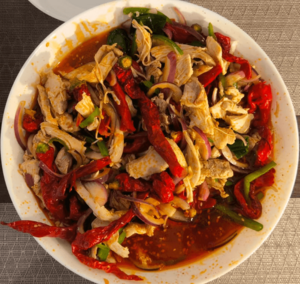Mala (seasoning) facts for kids
Quick facts for kids Mala |
|||||||||||||||||||
|---|---|---|---|---|---|---|---|---|---|---|---|---|---|---|---|---|---|---|---|

Jiāomájī (椒麻鸡), a cold chicken dish flavored with mala
|
|||||||||||||||||||
| Chinese | 麻辣 | ||||||||||||||||||
|
|||||||||||||||||||
Mala is a special kind of spicy and numbing seasoning. It's made from Sichuan peppercorns and chilli. Most often, mala is turned into a sauce called málàjiàng (麻辣醬). This sauce is made by cooking the ingredients slowly in oil with other spices. Mala is a key part of Sichuan cuisine, especially in Chongqing. It has become one of the most popular flavors in Chinese cooking, with many different versions found across China.
What is Mala?
The name málà comes from two Chinese characters. "Ma" (麻) means "numbing," and "la" (辣) means "spicy." So, mala describes the unique numbing and spicy feeling you get in your mouth when you eat it. The numbing feeling comes from the Sichuan pepper.
How Mala Began
No one knows exactly when mala started. But many people believe it first appeared in the night markets of Chongqing. This was between the 1800s and early 1900s. It was often served to workers who loaded and unloaded boats at the piers. The strong flavor and thick layer of oil in mala helped keep foods fresh. It also made less popular foods, like certain meat parts, taste better.
Even though mala is very flavorful on its own, people often eat it with dipping sauces. These sauces can make the cooked meat feel smoother and taste even more interesting. Common dipping sauces include sesame oil with garlic, or oyster oil.
What's in Mala Sauce?
The main ingredients for mala sauce are dried chili peppers, chili powder, and Sichuan peppercorns. Other spices like clove, garlic, star anise, ginger, cinnamon, salt, and sugar are also used. These ingredients are cooked for many hours with beef fat and vegetable oil. Sometimes, other herbs like sand ginger or poppy seeds are added to create special flavors.
In the past, restaurants would hire a chef just to make their secret mala sauce. Today, you can easily find ready-made mala sauce in supermarkets. Many chain restaurants also make their own sauce in large amounts. Just like with curry, there are many different recipes, and people often debate which one is the "best."
Dishes with Mala
Mala sauce is used in many different kinds of dishes. You can find it in stir-fries, stews, and soups. It's also very popular in hot pot or as a dipping sauce. In the Sichuan and Yunnan provinces, mala powder (麻辣粉) is sprinkled on snacks and street foods. These include stinky tofu, fried potatoes, and barbecued meats and vegetables.
Here are some popular dishes that use mala:
- Malatang (麻辣燙): This dish has vegetables and meat skewers served in a mala soup. For cooking at home, instant mala cubes are popular.
- Mala hot pot (麻辣火鍋): A boiling pot of mala broth where you cook your own ingredients.
- Mala shaokao (麻辣烧烤): Chinese barbecue that is flavored with mala spices.
- Mala xiang guo (麻辣香锅): A delicious stir-fry dish flavored with mala sauce.
- Mala duck neck (麻辣鴨脖子): Duck neck seasoned with mala.
- Mouth-watering ("drooling") chicken (口水雞): A cold chicken dish served with mala sauce.
- Fuqi feipian (夫妻肺片): This dish includes beef tendon, tongue, and tripe, served with oily mala sauce.
- Dapanji (大盘鸡): Also known as "big plate chicken," this is a hearty stew with chicken, potatoes, and noodles, all flavored with mala.
See also
 In Spanish: Salsa mala para niños
In Spanish: Salsa mala para niños

